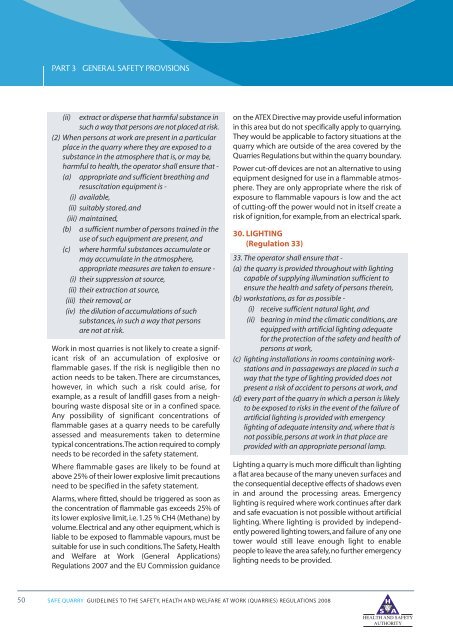Safe Quarry - Health and Safety Authority
Safe Quarry - Health and Safety Authority
Safe Quarry - Health and Safety Authority
You also want an ePaper? Increase the reach of your titles
YUMPU automatically turns print PDFs into web optimized ePapers that Google loves.
PART 3<br />
GENERAL SAFETY PROVISIONS<br />
(ii) extract or disperse that harmful substance in<br />
such a way that persons are not placed at risk.<br />
(2) When persons at work are present in a particular<br />
place in the quarry where they are exposed to a<br />
substance in the atmosphere that is, or may be,<br />
harmful to health, the operator shall ensure that -<br />
(a) appropriate <strong>and</strong> sufficient breathing <strong>and</strong><br />
resuscitation equipment is -<br />
(i) available,<br />
(ii) suitably stored, <strong>and</strong><br />
(iii) maintained,<br />
(b) a sufficient number of persons trained in the<br />
use of such equipment are present, <strong>and</strong><br />
(c) where harmful substances accumulate or<br />
may accumulate in the atmosphere,<br />
appropriate measures are taken to ensure -<br />
(i) their suppression at source,<br />
(ii) their extraction at source,<br />
(iii) their removal, or<br />
(iv) the dilution of accumulations of such<br />
substances, in such a way that persons<br />
are not at risk.<br />
Work in most quarries is not likely to create a significant<br />
risk of an accumulation of explosive or<br />
flammable gases. If the risk is negligible then no<br />
action needs to be taken. There are circumstances,<br />
however, in which such a risk could arise, for<br />
example, as a result of l<strong>and</strong>fill gases from a neighbouring<br />
waste disposal site or in a confined space.<br />
Any possibility of significant concentrations of<br />
flammable gases at a quarry needs to be carefully<br />
assessed <strong>and</strong> measurements taken to determine<br />
typical concentrations.The action required to comply<br />
needs to be recorded in the safety statement.<br />
Where flammable gases are likely to be found at<br />
above 25% of their lower explosive limit precautions<br />
need to be specified in the safety statement.<br />
Alarms, where fitted, should be triggered as soon as<br />
the concentration of flammable gas exceeds 25% of<br />
its lower explosive limit, i.e. 1.25 % CH4 (Methane) by<br />
volume. Electrical <strong>and</strong> any other equipment, which is<br />
liable to be exposed to flammable vapours, must be<br />
suitable for use in such conditions.The <strong>Safe</strong>ty, <strong>Health</strong><br />
<strong>and</strong> Welfare at Work (General Applications)<br />
Regulations 2007 <strong>and</strong> the EU Commission guidance<br />
on the ATEX Directive may provide useful information<br />
in this area but do not specifically apply to quarrying.<br />
They would be applicable to factory situations at the<br />
quarry which are outside of the area covered by the<br />
Quarries Regulations but within the quarry boundary.<br />
Power cut-off devices are not an alternative to using<br />
equipment designed for use in a flammable atmosphere.<br />
They are only appropriate where the risk of<br />
exposure to flammable vapours is low <strong>and</strong> the act<br />
of cutting-off the power would not in itself create a<br />
risk of ignition, for example, from an electrical spark.<br />
30. LIGHTING<br />
(Regulation 33)<br />
33. The operator shall ensure that -<br />
(a) the quarry is provided throughout with lighting<br />
capable of supplying illumination sufficient to<br />
ensure the health <strong>and</strong> safety of persons therein,<br />
(b) workstations, as far as possible -<br />
(i) receive sufficient natural light, <strong>and</strong><br />
(ii) bearing in mind the climatic conditions, are<br />
equipped with artificial lighting adequate<br />
for the protection of the safety <strong>and</strong> health of<br />
persons at work,<br />
(c) lighting installations in rooms containing workstations<br />
<strong>and</strong> in passageways are placed in such a<br />
way that the type of lighting provided does not<br />
present a risk of accident to persons at work, <strong>and</strong><br />
(d) every part of the quarry in which a person is likely<br />
to be exposed to risks in the event of the failure of<br />
artificial lighting is provided with emergency<br />
lighting of adequate intensity <strong>and</strong>, where that is<br />
not possible, persons at work in that place are<br />
provided with an appropriate personal lamp.<br />
Lighting a quarry is much more difficult than lighting<br />
a flat area because of the many uneven surfaces <strong>and</strong><br />
the consequential deceptive effects of shadows even<br />
in <strong>and</strong> around the processing areas. Emergency<br />
lighting is required where work continues after dark<br />
<strong>and</strong> safe evacuation is not possible without artificial<br />
lighting. Where lighting is provided by independently<br />
powered lighting towers,<strong>and</strong> failure of any one<br />
tower would still leave enough light to enable<br />
people to leave the area safely,no further emergency<br />
lighting needs to be provided.<br />
50<br />
SAFE QUARRY GUIDELINES TO THE SAFETY, HEALTH AND WELFARE AT WORK (QUARRIES) REGULATIONS 2008
















